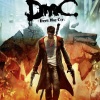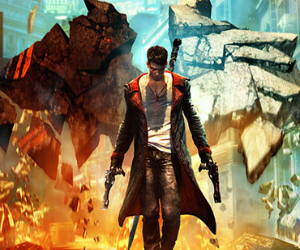 Ninja Theory were an interesting choice of developer for Capcom to select as the chosen ones responsible for giving their IP a kick up the arse. They began their career promisingly with fun brawler Kung Fu Chaos, before progressing onto the excellent Heavenly Sword, a thoughtful melee brawler that was packed with excellent touches including motion capture from Andy Serkis, voice acting from Steven Berkoff and a soundtrack composed by Nitin Sawnhey.
Ninja Theory were an interesting choice of developer for Capcom to select as the chosen ones responsible for giving their IP a kick up the arse. They began their career promisingly with fun brawler Kung Fu Chaos, before progressing onto the excellent Heavenly Sword, a thoughtful melee brawler that was packed with excellent touches including motion capture from Andy Serkis, voice acting from Steven Berkoff and a soundtrack composed by Nitin Sawnhey.
Without hesitation Ninja Theory stated that it was their opportunity to disregard the plot and aesthetics of the previous games in the series, and rebuild Devil May Cry from the ground up. Of course this begins with Dante, a much beloved figure, no doubt, but one who had become something of a one dimensional animé badass cliché, who had not really moved on since the first game in the series. The whole demon slaying thing needed a re-jig too. Dante using lavish combos to take down otherworldly foes, and defeat enormous bosses has always been fun, but we definitely needed a new angle, a new motivation for Dante to be battling in the first place.
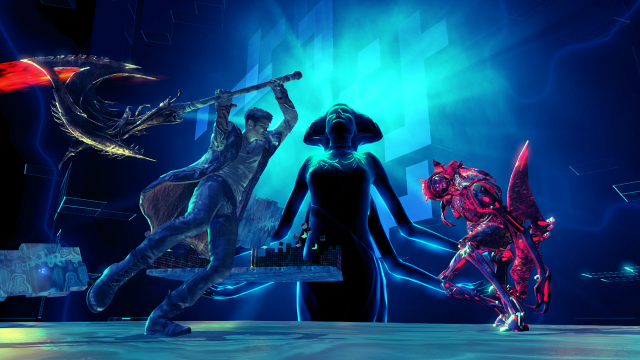
Let me make one thing clear. If you are one of the many for whom the alteration of Dante’s appearance was simply too much to bear, then by ignoring DmC you will be cutting off your nose to spite your face. The reaction to this all-new son of Sparda has been something to behold to say the least. It has been a bit like the many football fans who call radio phone-ins on a weekly basis, only instead of spouting stuff like “If Arsene Wenger picks Gervinho again I am tearing up my season ticket”, it is “If Capcom don’t restore Dante’s white barnet, I am abandoning the series forthwith”. I don’t know of any football fan who has genuinely bitten the bullet and turned their back on the sport, and nor should any long-time fans of the Devil May Cry series abandon it now. You lived through Nero, kids! You had to endure the dreadful second game in the series. You can handle a bit of reboot, surely? Believe me, you will not be disappointed.
We have been lucky enough to spend some time with the first ten stages of DmC to find out just how Ninja Theory have coped with the license.
The first thing I noticed was that the inherently dark creepiness of prime DmC is still very much in place, even if things look a bit different. Much of the front end and loading screens focus on a mysterious red pendant, and flickering, just-out-of-focus pictures of a young Dante with his mother. We then meet the grown man version of our hero, recovering from a night on the town, obviously a man who is no stranger to excess, whether that is through wine, women or song. This new Dante is wiry, bristling with energy, cocky as hell and foul mouthed with it; he could have been pulled from the stage of a punk rock show at CBGBs, circa 1978. He resides in a trailer, perched on a pier that evokes the kind of faded fairground glamour of a Coney Island. We learn over time that it isn’t just the outward appearance that has completely altered – unlike his white haired predecessor, who would have had Sparda and a human parent on his birth certificate – this lad is the offspring of Sparda and an angel. It is this important change that helps to explain one of the key fighting mechanics in the game.
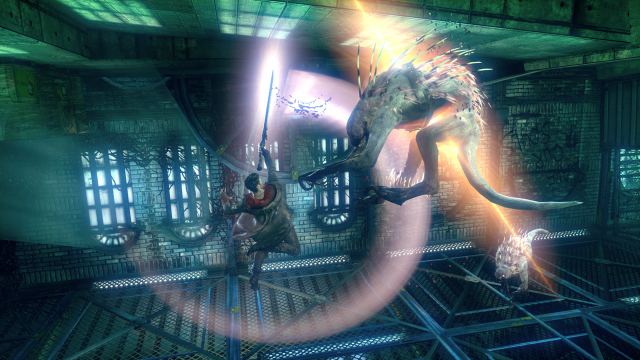
Through cutscenes we establish that demons live amongst humans, using their powers of subversion, lies and propaganda to infiltrate and ultimately take over the world. Demons have their own exclusive nightspots, reminiscent of the secret vampire society so cleverly implemented in the Blade movies. Demons run the media, we are told. A man claiming on television to be a saviour is in fact long time Dante nemesis Mundus in disguise, going about his business of slowly but surely encircling mankind in his death grip.
After being attacked by a Hunter Demon that opens up his caravan like a tin of beans, the alcohol sodden, partially naked Dante is drawn into Limbo, a brilliantly realised alternative demonic reality that exists in parallel with our own. Limbo is an unsettling, garishly coloured place. Gone are the days when Dante is simply sealed in a room until he defeats all the bad guys – now he is trapped in the enemy realm, where nothing is quite as it seems. It looks incredible. The colours are purposely exaggerated, meaning the action is a bathed in a sickening mix of neons, reds and oranges that create a real sense of unease. The fairground takes on a scary life of its own as a ferris wheel detaches itself, the pier begins to crumble into the sea, and arcade cabinets dotted around the funfair (including a Street Fighter II cab, featuring a visible Ryu Vs. Ken battle – squeeee!!) crumple in on themselves as you pass. The environment terraforms as you move along, constantly changing, bending, almost seeming to leer at you. The whole of Limbo feels like a threatening, malevolent, organic thing and creates the perfect setting for a dust up with a bunch of hellspawn. Let battle commence!
Any shred of doubt you may have had to begin with is eliminated the moment you pull out Rebellion and let the combos flow. Once you have mastered the basics of standard attacks, launchers (for which there is now a dedicated button), air juggles and all of the other entry-level moves in Dante’s arsenal, you are introduced to Ebony and Ivory. Things then start to slot into place, and new abilities are drip fed to you – purchased from Divinity Statues along the way using the classic in-game currency we know and love – red orbs – yaay! This is classic Devil May Cry combat, the same amazing, fluid combinations, boss encounters, smart-ass quips (from both sides too, the first boss you meet, a hideous maggot creature, can dish out colourful put-downs with the best of them) but with a new energy, a definite fresh feel.
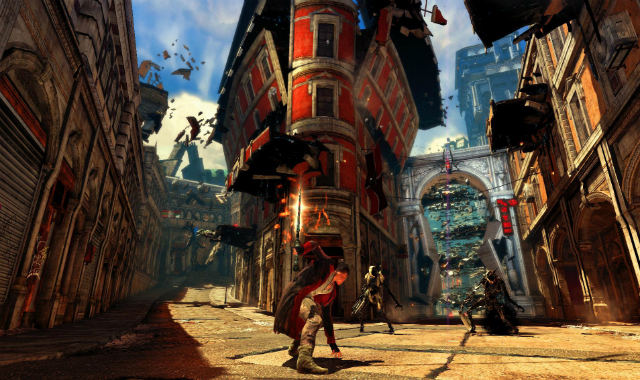
Remember the fact that Dante has mixed demon/angel heritage? This is also reflected in his combat abilities, with triggers used as combo modifiers, a system not entirely dissimilar to the one found in the excellent Castlevania: Lords of Shadow. The angelic side of Dante’s personality manifests itself in the form of a scythe called Osiris, which can be used to swat approaching enemies, whereas his darker side uses a heavy axe called Arbiter, capable of dishing out some serious (and sometimes unblockable) pain. There are also evasive and defensive manoeuvres tied into the yin and yang sides of Dante, giving bursts of invulnerability or allowing you to power up for a brief period of time. Some enemies can only take damage from certain weapons, meaning that you will need to detect their weakness and use the correct trigger to whoop their demonic ass.
Joining the four main weapons this time around is a new Demon Pull ability, a grappling hook which is used to traverse the often treacherous landscape within Limbo, but can later be employed very impressively to grab hold of enemies and draw them toward you. Every tool in Dante’s death dealing, high flying repertoire is a treat to use, and the combo potential is positively endless, particularly once you unlock more of the lovely red orb-funded abilities and weapons upgrades. One thing I did notice, however, is that the ranking system is slightly different from previous games in the series. Where, say, Devil May Cry 3 rewarded you for the variety and style of your attacks, here you achieve top billing simply by string out an attack for as long as possible. This is a far more intuitive system, and doesn’t detract from the genius weapon swapping of old, as there are literally so many ways you can beat someone up.
Start out with a standard combo, launch them into the air, carry out an Aerial Rave (AERIAL RAVE!), bounce off of their head using the Enemy Step ability, pop a few caps in their ass courtesy of your trusty pistols, before using your grappling skills to bounce them into the turf and then pull them up again for another taste of Rebellion. What I have just described is one of the more basic combinations. You can do so much more, creating a wonderful, acrobatic, balletic display of death with your sweary new emo-punk friend.
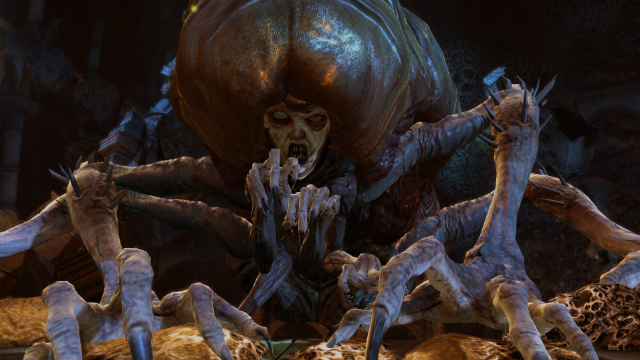
Based on the first half of the game, Ninja Theory and Capcom have really done the business with DmC. Apart from a bit of misogyny which didn’t sit tremendously well with me, the new Dante works perfectly, his angry young man persona befitting the horrific world that he is called upon to save. The plot is a delicious mixture of demonic goings on, with references to terrorism, politics, the use of the media to subvert the masses and even the Anonymous movement detectable along the way. Dante is properly fleshed out with an all-new backstory, which goes some way toward explaining the way he is and what motivates him to do what he does. We all loved the old Dante, but this new creation is to be embraced as well, as this looks like being a stunning way for the series to re-enter the gaming fray.
DmC: Devil May Cry will be released on January 15, 2013 for Xbox 360 and PlayStation. The Windows PC version will be released on January 25, 2013. Check out our 10 minute video preview, here.


